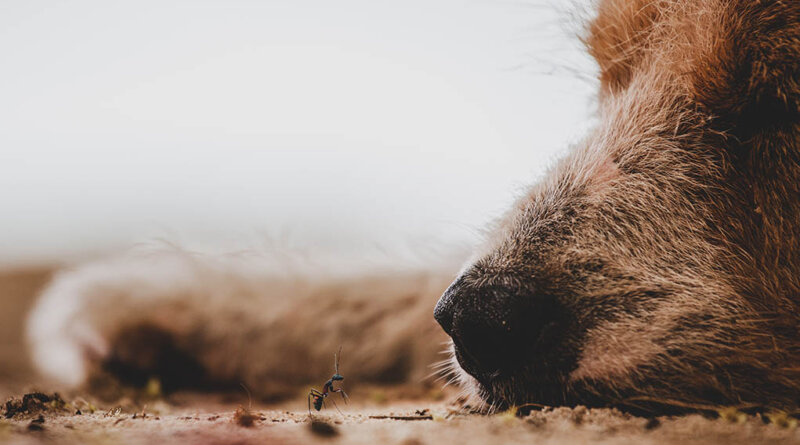Symptoms, Treatment, And Prevention – Top Dog Tips
It may seem like an ordinary day until your dog is bitten by an ant.
Sometimes our dogs can be too adventurous and all we can do is help them out afterward!
If your pooch has found themselves venturing into an ant’s nest and got themselves in trouble, let’s find out about ant bites in dogs!
Although not all ant bites in dogs are not dangerous, some dogs may suffer anaphylactic reactions. It’s important to monitor the dog’s condition for the time being.
Ants have over 10,000 species but fire ant bites in dogs may be the most threatening for our fur buddies.
Fire Ants have a venom known as “piperidine”. This alkaloid can cause inflammation in the bittern area.
Harvester Ants, Leafcutters, and Carpenter Ants are species that owners should also watch out for.
Ant Bites in Dogs
Since dogs are often found walking around and sniffing anywhere, there are more common places for ant bites.
This may occur especially when they’re outdoors or in places where there is food.
Although ants may bite dogs anywhere, there are more prone body parts for ant bites.
Primary targets for Ant Bites in Dogs are found in:
Symptoms for Ant Bites in Dogs
Ant bites may occur in other body parts as well. It’s best to inspect the dog’s body for any bites.
This can be difficult for long-haired or thick-haired dogs.
There is a variety of ants but there are common symptoms for ant bites. Here are some common symptoms:
- Visible multiple bites
- Sores
- Inflammation around the bitten area (Localized swelling and reddening)
- Repetitive itching of the bitten area
- Repetitive licking or biting of the bitten area
- Repetitive pawing of the bitten area
- Restlessness
- Whining
Unfortunately, some ants bites in dogs may cause anaphylactic reactions. Here are the symptoms to watch out for:
- Excessive inflammations
- Difficulty in breathing
- Weakness
- Diarrhea
- Pallor
- Collapsing
For dogs who are having anaphylactic reactions, it’s important to bring them to the veterinarian immediately.
If the anaphylactic reactions are prolonged and not addressed immediately, they may go into shock, affect some organs and possibly be fatal.
Diagnosis for Ant Bites in Dogs
Consultation & Physical Evaluation
Owners may evaluate their dogs at home for ant bites.
But it’s still best to contact the veterinarian for any precautions that may happen.
When the symptoms worsen or do not subside for long periods, it is advisable to undergo a thorough physical evaluation with the veterinarian.
Veterinarians may further check the dog for any other complications as well.
This can help address any other symptoms and have the dog administer any necessary medication.
Treatment for Ant Bites in Dogs
It’s best to treat ant bites immediately as they may induce repetitive scratching and biting which may lead to lesions and then infections.
Unfortunately, ant bites are also sometimes painful.
Before going through treatment, owners must make sure there are no more ants on their dogs to reduce any more inflammation and rashes.
If there any ants are spotted, owners may brush them out or use a damp towel to remove them.
Be cautious with fire ants as their bite is very painful. Make sure to use gloves when removing them.
Owners may contact their veterinarians for assistance or guidance, regarding the ant bites.
Veterinarians may advise doing the following:
Apply an Ice Pack to the Bitten Area
Owners may find the ant bite and apply cold pressure. Once the ant bite area is found, owners may apply a cold pack for 5 minutes.
Remove the pack and apply cold pressure again, this is to prevent frostbite on the area.
This can be done for 20-30 minutes or until the area has improved.
If the ant bite is on the forelegs, feet, or paws, owners may soak the feet in cold water instead. The same duration applies.
Soak the area for 5 minutes and remove it for a while, then soak again.
This can be done for 20-30 minutes or until the area has improved.
Prevent Your Pet from Licking and Biting the Bitten Area
Inevitably, the ant bite will be prickly. Repetitive licking and biting can cause new lesions to the bitten area.
So owners need to prevent their pets from licking and biting the bitten area.
Owners may use an e-collar, inflatable collars, or sleeves to cover the area for a while.
For more preventive measures, owners may also use toys or treats to distract their dogs until the ant bite has improved.
Monitor Your Pet’s Condition
Ant bites in dogs can subside after a while. After getting home treatment, ant bite symptoms may lessen in no time.
Unfortunately, some dogs have a slower or different response to ant bites and other have allergic reactions to them as well.
Owners may monitor their dog’s condition for any cautionary measures.
If the symptoms do not alleviate for a long period, they should contact their veterinarian immediately as the dog may have undergone an anaphylactic reaction.
Oral or Injected Administration
Some dogs who have ant bites may be prescribed medication by the veterinarian. These are for those who have severe symptoms.
Veterinarians may prescribe Benadryl or diphenhydramine with specific dosages.
It’s important to consult with the veterinarian regarding these medications as they may have adverse effects if taken improperly.
Home Remedies
Some home remedies can also be used to alleviate the dog’s condition. Owners may also use
Aloe vera gel, apple cider vinegar, and baking soda salve to relieve itchiness and pain.
Owners may ask their veterinarians what other home remedies they may use for mild symptoms of ant bites.
It’s important to consult with the veterinarian for products that will be applied to the dogs as some products are not pet-friendly.
Prevention for Ant Bites in Dogs
Although owners can not ultimately avoid Ant bites in Dogs, there are some ways to prevent them.
Owners can watch out for where their dogs are sniffing and wandering about.
In areas like backyards, parks, forests, or areas with soil, owners may be extra cautious and watch out the trail for ants.
Owners may also avoid ant bites in dogs by removing food from the floor or any area where it’s accessible to the dog.
Ants may accumulate in areas where food is present, especially food crumbs on the floor or in the kitchen.
Frequently Asked Questions
How do dogs react to Ant bites?
Dogs will physically react to ant bites by whining, scratching, and pawing the area of bitten area.
Dogs will repeatedly scratch and bite the bitten area as well as it may be itchy and painful.
Can dogs eat ants?
Yes, sometimes ants may be in the food bowl and consumed by the dog. Don’t worry—ants are not poisonous to dogs.
But it’s best not to have their bowls cleaned before any meals to prevent other insects or worms from inhibiting the bowl.
Does Benadryl help with ant bites in dogs?
Benadryl alleviates the inflammation in insect bites. It can help dogs with a bad reaction to insect bites.
Ant Bites in Dogs: Summary
Ant Bites in dogs are generally not dangerous unless the dog has an allergic reaction and goes to anaphylactic shock.
Nevertheless, owners should always consult with the veterinarian to make sure we are doing things right!
Insect bites and parasite bites are also somewhat similar, so it’s best to have a consultation with the veterinarian to further examine the bitten area.
There’s nothing wrong with being sure about your dog’s condition.
This can be a preventive measure for any conditions in the future as well.
RELATED: 5 WAYS TO DEAL WITH A SPIDER BITE ON A DOG
Related







